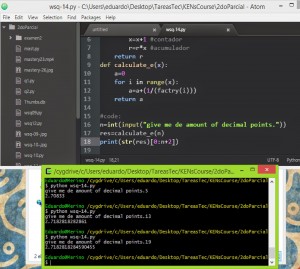with this WSQ I learned how to open files in python. and do different things with them.
"open() returns a file object, and is most commonly used with two arguments: open(filename, mode).
>>> f = open('workfile', 'w')
>>> print f
<open file 'workfile', mode 'w' at 80a0960> I reversed engeneered Efrain's code to see what he tried to do in order to learn.
LINK TO CODE.
Continue reading ]]>
with this WSQ I learned how to open files in python. and do different things with them.
“open() returns a file object, and is most commonly used with two arguments: open(filename, mode).
The first argument is a string containing the filename. The second argument is another string containing a few characters describing the way in which the file will be used. mode can be 'r' when the file will only be read, 'w' for only writing (an existing file with the same name will be erased), and 'a'opens the file for appending; any data written to the file is automatically added to the end. 'r+' opens the file for both reading and writing. The modeargument is optional; 'r' will be assumed if it’s omitted.” – Python.org
I reversed engeneered Efrain’s code to see what he tried to do in order to learn.
]]>with this WSQ I learned how to open files in python. and do different things with them.
"open() returns a file object, and is most commonly used with two arguments: open(filename, mode).
>>> f = open('workfile', 'w')
>>> print f
<open file 'workfile', mode 'w' at 80a0960> I reversed engeneered Efrain's code to see what he tried to do in order to learn.
LINK TO CODE.
Continue reading ]]>
with this WSQ I learned how to open files in python. and do different things with them.
“open() returns a file object, and is most commonly used with two arguments: open(filename, mode).
The first argument is a string containing the filename. The second argument is another string containing a few characters describing the way in which the file will be used. mode can be 'r' when the file will only be read, 'w' for only writing (an existing file with the same name will be erased), and 'a'opens the file for appending; any data written to the file is automatically added to the end. 'r+' opens the file for both reading and writing. The modeargument is optional; 'r' will be assumed if it’s omitted.” – Python.org
I reversed engeneered Efrain’s code to see what he tried to do in order to learn.
]]>with this WSQ I learned how to open files in python. and do different things with them.
"open() returns a file object, and is most commonly used with two arguments: open(filename, mode).
>>> f = open('workfile', 'w')
>>> print f
<open file 'workfile', mode 'w' at 80a0960> I reversed engeneered Efrain's code to see what he tried to do in order to learn.
LINK TO CODE.
Continue reading ]]>
with this WSQ I learned how to open files in python. and do different things with them.
“open() returns a file object, and is most commonly used with two arguments: open(filename, mode).
The first argument is a string containing the filename. The second argument is another string containing a few characters describing the way in which the file will be used. mode can be 'r' when the file will only be read, 'w' for only writing (an existing file with the same name will be erased), and 'a'opens the file for appending; any data written to the file is automatically added to the end. 'r+' opens the file for both reading and writing. The modeargument is optional; 'r' will be assumed if it’s omitted.” – Python.org
I reversed engeneered Efrain’s code to see what he tried to do in order to learn.
]]>1. Will finish WSQ´s by the end of this week, hopefully
2. Will finish my Masteries by the end of the month, I'll try to make mostly videos.
3. Study off of old exams to study for the final.
Continue reading ]]>
1. Will finish WSQ´s by the end of this week, hopefully
2. Will finish my Masteries by the end of the month, I’ll try to make mostly videos.
3. Study off of old exams to study for the final.
1. Will finish WSQ´s by the end of this week, hopefully
2. Will finish my Masteries by the end of the month, I'll try to make mostly videos.
3. Study off of old exams to study for the final.
Continue reading ]]>
1. Will finish WSQ´s by the end of this week, hopefully
2. Will finish my Masteries by the end of the month, I’ll try to make mostly videos.
3. Study off of old exams to study for the final.
1. Will finish WSQ´s by the end of this week, hopefully
2. Will finish my Masteries by the end of the month, I'll try to make mostly videos.
3. Study off of old exams to study for the final.
Continue reading ]]>
1. Will finish WSQ´s by the end of this week, hopefully
2. Will finish my Masteries by the end of the month, I’ll try to make mostly videos.
3. Study off of old exams to study for the final.
Code:
https://github.com/EduardoMerino/Sharing-for-Class/blob/master/wsq-14.py
Reference links:
https://docs.python.org/3/tutorial/introduction.html#lists
Code:
https://github.com/EduardoMerino/Sharing-for-Class/blob/master/wsq-14.py
Reference links:
https://docs.python.org/3/tutorial/introduction.html#lists





